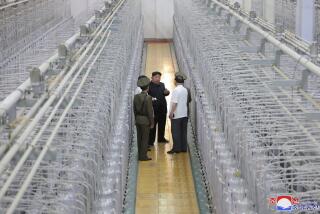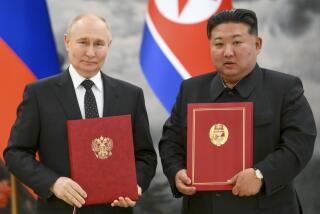U.S., N. Korea Spell Out Details of Nuclear Agreement : Asia: Accord paves way for South to help build new reactors for Pyongyang. It follows months of wrangling.
WASHINGTON â The Clinton Administration and North Korea took a significant step Tuesday in their effort to negotiate an end to Pyongyangâs nuclear weapons program and work out an accommodation with each other.
After more than three weeks of talks in Kuala Lumpur, Malaysia, the governments reached a written agreement spelling out how the United States, South Korea and Japan will provide North Korea with new energy supplies while Pyongyang freezes its nuclear facilities.
The accord increases the likelihood that the original, sketchier nuclear deal between the Administration and North Korea, signed last October, will be carried out. Until Tuesday, North Korea had been quibbling with and balking at understandings that the United States claimed had been reached earlier. âWeâre moving down the road,â one State Department official observed.
In a week or two, U.S. officials are expected to travel to North Korea to work on safely storing large amounts of spent nuclear fuel that were removed last year from North Korean facilities at Yongbyon--and which could have been used to produce as many as five weapons.
âThis is indicative of a broader change in the outlookâ of North Korea, said Selig Harrison of the Carnegie Endowment for International Peace, who has made several trips to North Korea. âThe regime is quite eager to improve relations with the United States and Japan, and this nuclear agreement is a symbol of that.â
He said one factor influencing the change is that North Korea has suffered serious shortages of food and energy supplies.
Under the agreement reached Tuesday, the Administration nailed down two crucial elements left hanging since October:
* Pyongyang in effect agreed to accept nuclear reactors from South Korea to help make up for energy it is losing by closing and eventually tearing down existing, more dangerous facilities. Until Tuesday, North Korea had refused to take reactors built by the rival regime in Seoul and suggested it wanted reactors from somewhere else, such as Germany or Russia.
* North Korea went along with having a South Korean firm serve as prime contractor in building the reactors. But an American firm will be named âprogram coordinator,â and Americans will lead multinational delegations handling the huge construction project.
In exchange, the United States made concessions of its own:
* The written agreement does not mention South Korea by name. Instead, it says reactors supplied to North Korea will have âtwo coolant loopsâ and will be âthe advanced-version of U.S.-origin designâ--a technical description of reactors manufactured in South Korea based on designs of an American firm, Combustion Engineering. âThey [the North Koreans] get their reactors, and they donât get humiliated,â one U.S. official explained.
* The Administration agreed that South Korea, Japan and the United States will pay $10 million to clear the reactor site. The October deal did not cover these costs, which North Korea did not want to pay.
The United States and North Korea have been negotiating since 1993, when Pyongyang refused to permit special international inspections of its nuclear facilities. Under the October deal, the Administration agreed to arrange for North Korea to get two light-water nuclear reactors. They are considered much safer than its existing, gas-graphite nuclear facilities, because it is much harder to produce weapons-grade plutonium from the light-water reactors.
The October deal specified that the new reactors would be supplied and financed by an international consortium, the Korean Energy Development Organization (KEDO)--the three key countries in this consortium being South Korea, Japan and the United States.
Although none of the countries has said what its share of the $4-billion reactor project will be, estimates are that South Korea will pay 60% to 70% of the total and Japan 25%. The United States will pay only a tiny proportion but will have the leading political role in KEDO, with Americans serving as its chairman and executive director.
Tuesdayâs deal opens the way for North Korea to begin dealing more directly with officials of the agency on the reactor project--thus giving a greater role to South Korean and Japanese officials who will be part of it. The accord also paves the way for the agency to supply North Korea with 100,000 tons of heavy fuel oil for its energy-starved factories.
More to Read
Sign up for Essential California
The most important California stories and recommendations in your inbox every morning.
You may occasionally receive promotional content from the Los Angeles Times.










